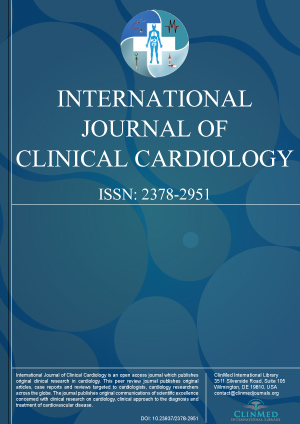Open Access DOI:10.23937/2378-2951/1410167
Radiofrequency Ablation as a Treatment Modality for Hypertrophic Cardiomyopathy
Kareem M. M. Ibrahim, MBBCH
Article Type: Review Article | First Published: Feb 29, 2020
Hypertrophic cardiomyopathy is one of the major causes of cardiac death that affects 1 in every 500 persons worldwide. Surgical myectomy and alcohol septal ablation have been the gold standard well established procedures for the treatment of this condition. Starting 2004 a new procedure, radiofrequency septal ablation, has been applied and showed significant improvement in the NYHA classification as well as the left ventricular outflow tract (LVOT) gradients of these patients. With overall less ...
Open Access DOI:10.23937/2378-2951/1410166
Percutaneous Repair of an Aortic Pseudoaneurysm Status Post-Surgical Repair of Stanford Type A Dissection
Brinder S Kanda, MD, FACC, FSCAI, Nicholas E Hoyt , John Haas, MD, Houman Tavaf-Motamen, MD, Ronald Morford, MD, Tina Wesley, BSN, Kenneth Saum, MD and Michael MacCormac, MD
Article Type: Case Report | First Published: Feb 29, 2020
A middle-aged Caucasian woman presented with an ascending aortic pseudoaneurysm (AAP) located at the suture site of her previous surgical dissection repair. The pseudoaneurysm was located along the anterior aspect of the ascending thoracic aorta, above the right coronary cusp. We demonstrate successful percutaneous repair of the pseudoaneurysm using a ventricular septal occluder (VSO) and discuss the significance of this procedure for future cardiovascular care. A 56-year-old Caucasian woman wit...
Open Access DOI:10.23937/2378-2951/1410165
Idiopathic Large Pericardial Effusion and Cardiac Tamponade in Children with Down Syndrome
Numra Aleem, MD, Amna Qasim, MD and Ashraf M Aly, MD, PhD
Article Type: Case Report | First Published: February 26, 2020
Pericardial effusions (PE) in patients with Down syndrome (Trisomy 21) have been associated with hypothyroidism, viral infections and malignancies (particularly leukemia). The PE is usually not large enough to cause cardiac tamponade. We report two cases of idiopathic large PE with one of them progressing to develop a cardiac tamponade that required an urgent pericardiocentesis. A 3-year-old female with Trisomy 21 was seen at cardiology clinic for follow up of a small secundum ASD. Patient has b...
Open Access DOI:10.23937/2378-2951/1410164
Electrical Cardioversion: A Review
Max E Valentinuzzi, EE, PhD and Luis Aguinaga Arriascu, MD
Article Type: Review Article | First Published: January 23, 2020
Atrial fibrillation (AF), not to be confused with atrial flutter, is the term used to describe an irregular or abnormal heart rate. While AF and atrial flutter are similar, AF has more serious health implications such as an increased risk of having a stroke or a blood clot (thrombosis). The resting heart rate of someone without AF is usually between 60 and 100 beats per minute but this number is usually over 100 in AF. It is usually the result of an underlying condition such as hypertension (hig...

